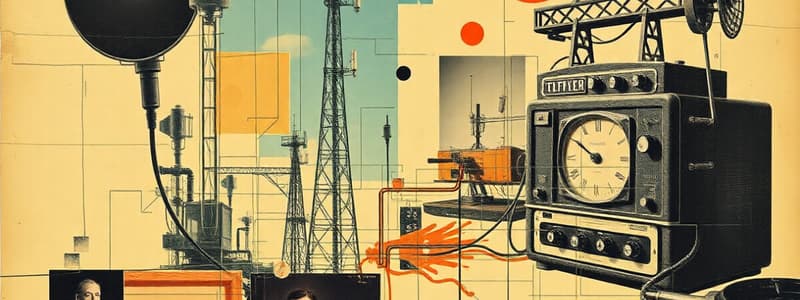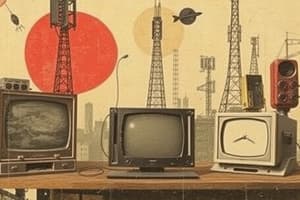Podcast
Questions and Answers
Which of the following is a primary focus of the session on the Information Technology Revolution?
Which of the following is a primary focus of the session on the Information Technology Revolution?
- Discussing the ethical considerations surrounding artificial intelligence and machine learning.
- Evaluating the role of social media in political campaigns and public discourse.
- Analyzing the economic impacts of digital technologies on global markets.
- Examining the development of communication systems from oral traditions to modern telecommunications. (correct)
Which of the following lists includes processes directly related to the 'ICT and the Information Field'?
Which of the following lists includes processes directly related to the 'ICT and the Information Field'?
- Information creation, information transmission, information storage, and management of information flow. (correct)
- Software development, database management, cloud computing and data analytics.
- Information transmission, data mining, knowledge creation, and cyber security.
- Digital marketing, content management, network administration, and systems analysis.
In the context of ICT, what does the 'management and control of information flow' primarily involve?
In the context of ICT, what does the 'management and control of information flow' primarily involve?
- Designing hardware infrastructure for enhanced network performance and stability.
- Creating systems to streamline the handling, organization, and distribution of information. (correct)
- Implementing strict censorship policies to limit the spread of misinformation.
- Developing algorithms for data encryption and decryption protocols.
How did the development of writing systems impact the management of information?
How did the development of writing systems impact the management of information?
Which characteristic is most accurate when describing cave paintings as a form of information record?
Which characteristic is most accurate when describing cave paintings as a form of information record?
What was a primary advancement represented by cuneiform over earlier forms of communication?
What was a primary advancement represented by cuneiform over earlier forms of communication?
How did the standardization of Chinese script under Shi Huangdi affect information and communication?
How did the standardization of Chinese script under Shi Huangdi affect information and communication?
Which factor primarily determines the nature of information storage?
Which factor primarily determines the nature of information storage?
Which is an accurate description of the evolution of book formats within the context of information storage?
Which is an accurate description of the evolution of book formats within the context of information storage?
What initiated the restoration of the Library of Alexandria, marking a library metamorphosis?
What initiated the restoration of the Library of Alexandria, marking a library metamorphosis?
Why is the development of methods for speeding up signals significant in the history of information technology?
Why is the development of methods for speeding up signals significant in the history of information technology?
What was a significant limitation of early human-based message movement systems?
What was a significant limitation of early human-based message movement systems?
How did the invention of photography contribute to advancements in the movement of messages?
How did the invention of photography contribute to advancements in the movement of messages?
In what specific way did the invention of the telegraph revolutionize communication?
In what specific way did the invention of the telegraph revolutionize communication?
Which innovation directly enabled radio voice transmission?
Which innovation directly enabled radio voice transmission?
What was a key contribution of the first electrical ignition system to the movement of messages?
What was a key contribution of the first electrical ignition system to the movement of messages?
How did the invention of the video tape recorder impact information handling?
How did the invention of the video tape recorder impact information handling?
How did early voice transmission contribute to ICT?
How did early voice transmission contribute to ICT?
What two factors determine information storage?
What two factors determine information storage?
What are the steps for to manage information?
What are the steps for to manage information?
Other than the library at Alexandria, what other technology was important for information storage?
Other than the library at Alexandria, what other technology was important for information storage?
What are considered static records for information storage?
What are considered static records for information storage?
What technology dates back to 3,500 BCE that greatly improved on information capture?
What technology dates back to 3,500 BCE that greatly improved on information capture?
What are some examples of ways to transfer information?
What are some examples of ways to transfer information?
Before paved roads, no electric utilities, no telephones, and no railways, what was one way to transport goods?
Before paved roads, no electric utilities, no telephones, and no railways, what was one way to transport goods?
What technology was invented by Samuel Morse in 1837?
What technology was invented by Samuel Morse in 1837?
Why are flags and signal ties important for communication?
Why are flags and signal ties important for communication?
What invention came about in 1843 by Alexander Bain?
What invention came about in 1843 by Alexander Bain?
What technology was invented in 1876?
What technology was invented in 1876?
WWw came to the market in which year?
WWw came to the market in which year?
What invention was created by Charles Guisburg in 1951?
What invention was created by Charles Guisburg in 1951?
When was the first prepaid postage stamp used?
When was the first prepaid postage stamp used?
When was the first airship launched?
When was the first airship launched?
When was the first commercial telegraph line established?
When was the first commercial telegraph line established?
Which technology came about in the late 1960s?
Which technology came about in the late 1960s?
What writing form dates back to 3,000 BCE?
What writing form dates back to 3,000 BCE?
Oracle bone inscriptions were from which writing system?
Oracle bone inscriptions were from which writing system?
When was the Chinese writing system standardized?
When was the Chinese writing system standardized?
Which of the following is a process of Informatics?
Which of the following is a process of Informatics?
What technologies were released in 1982?
What technologies were released in 1982?
Flashcards
ICT and Information Field
ICT and Information Field
ICT involves processes like information creation, transmission, storage, and management.
Information Creation and Capture
Information Creation and Capture
Creating or capturing information through memorization, writing, photography, audio recording, digitization, etc.
Information Transmission
Information Transmission
Transferring information through various channels like CDs, books, letters, broadcast, or digital networks.
Information Storage
Information Storage
Signup and view all the flashcards
Management and Control Information Flow
Management and Control Information Flow
Signup and view all the flashcards
Managing Information
Managing Information
Signup and view all the flashcards
Oral tradition
Oral tradition
Signup and view all the flashcards
Writing
Writing
Signup and view all the flashcards
Cave paintings
Cave paintings
Signup and view all the flashcards
Limitations of cave paintings
Limitations of cave paintings
Signup and view all the flashcards
Cuneiform
Cuneiform
Signup and view all the flashcards
Hieroglyphics
Hieroglyphics
Signup and view all the flashcards
First organized library
First organized library
Signup and view all the flashcards
Library metamorphosis
Library metamorphosis
Signup and view all the flashcards
Information record changes
Information record changes
Signup and view all the flashcards
Movement of messages is expedited.
Movement of messages is expedited.
Signup and view all the flashcards
Problems of human movement of messages
Problems of human movement of messages
Signup and view all the flashcards
19th C improvements on information
19th C improvements on information
Signup and view all the flashcards
Mid-19th century innovations
Mid-19th century innovations
Signup and view all the flashcards
Late 19th-century
Late 19th-century
Signup and view all the flashcards
Innovations for Movement of Messages.
Innovations for Movement of Messages.
Signup and view all the flashcards
Innovations in Movement of Messages cont'd.
Innovations in Movement of Messages cont'd.
Signup and view all the flashcards
Innovations in Messages' Transit Cont'd
Innovations in Messages' Transit Cont'd
Signup and view all the flashcards
Late 20th Century tech
Late 20th Century tech
Signup and view all the flashcards
Study Notes
- Information Technology revolutionized the generation and distribution of information
- This session covers the evolution of communications from oral tradition to writing, publishing, and telecommunications
Session Objectives
- Be able to trace the development of communication systems for transmission of information
- Be able to explain how differences in information transfer through various communication systems have affected the use of information in society
- Be able to explain the importance of standardization in information communication and transmission
Session Outline
- Topic 1: ICT and the Information Field
- Topic 2: The first ICT Revolution: Writing
- Topic 3: Information Storage
- Topic 4: The Second ICT Revolution: Movement of Messages
ICT and the Information Field Processes
- Digital technology is not the start of the ICT revolution
- Human voice dates back 30,000 years as an instrument to exchange of information
- ICT and the information field entail four processes:
- Information creation and capture
- Information transmission
- Information storage
- Management and control information flow
Information Creation and Capture
- Memorization
- Writing
- Photography
- Audio Recording
- Digitization
Information Transmission
- CDs, Books, Letters, Broadcasts
- Carrier Pigeons
- In one's head
- Post Office
- Broadcast over the airways: Satellite, Radio, Television
- Through Cable
- Telephone, Telegraphy, Internet
- Voice
- Signal Ties
- Flags
- Electrical and Optical Signals
- Human Language
Information Storage
- Information storage depends on the urgency to retrieve stored information and the information's initial packaging
- Storage went from pigeon holes to book shelves
Management and Control Information Flow
- Informatics involves creating systems to facilitate management and control of information flow
- Informatics includes the study, design, and development of information technology that generates, stores, processes, and presents information
The First ICT Revolution: Writing
- Information is managed through sharing, taking two steps
- First step: Transfer information from one medium to another
- This involves Oral tradition and writing
- Oral tradition includes storytelling, recounting national & ethnic epics, and theatre
- Second step: Writing captures ideas in a permanent way, this constitutes the first information technology revolution
Cave Paintings
- Paleolithic paintings are the first known recorded information and date back to 30,000-32,000 BC
- Cave paintings include representations of animals and nude Venus figures
- Paintings are found in caves at Chauvret-Pont-d'arc, Lascaux, Grotte Cosquer, elsewhere in Europe, South America, and Australia
- These paintings may be magic spells, prayers, documentation of hunts, efforts to communicate to then contemporaries, gods, or descendants
- Cave paintings are static, unsharable over space, and non-portable
- Cave paintings symbolized religions' architecture, especially medieval cathedrals
Formal Writing Systems
-
Cuneiform dates back to 3,500 BCE and was developed by Sumerians
-
Cuneiform is wedge-shaped writing used for financial records/inventories
-
Cuneiform was complex with more than 2000 symbols that were reduced by more than half
-
Hieroglyphics date back to about 3,000 BCE, developed by Egyptians, also called 'Writing of the Gods'
-
Hieroglyphics contains three symbols: pictographs (representations of objects), ideographs (representation of ideas), and an alphabet (representing phonetic)
-
Summerian writing preserved complex records, mythology, Gilgamesh epics and the Code of Hammurabi (1795-1750 BCE)
-
Egyptian Writing preserved the History of Egypt and the Egyptian Book of the Dead (1240 BCE)
-
Chinese writing dates back to 1,200 BCE
-
Oracle Bone Inscriptions date back to 1899
-
Bronze Inscriptions date back to 1,000 BCE
-
Shi Huangdi standardized Chinese script in 221 BCE
Information Storage introduction
- Information storage and writing are intertwined
- The Sumerian clay tablets discovered by Archeologists (Casson, 2001) were the first organized library
- The library at Alexandria was also important
The Ptolemaic Dynasty
-
It went through restoration by UNESCO
-
The Dynasty underwent Library metamorphosis
-
This lead to a changed perception of the role of libraries
-
Further change in the form of the book
-
From Clay tablet
-
To Scroll
-
To Codex
-
To Digital
-
Books could be Handwritten, brush written, pen written, or Ink-jet printed
-
The information age has new book formats, the hard disk, and hand held book readers books
The Second ICT Revolution: Movement of Messages
- Speeding up signals involves drums (sound waves), smoke (light waves), signal ties, light houses, semaphore, and flags
- Problems with Human Movement of Messages
- Transmission of signals over short distances, difficulties in sending complex messages accurately, and it is a time consuming process
19th C Improvements in Movement of Messages
-
At the beginning of the 19th century there were No paved roads, railways, telephones, or electric utilities.
-
Goods, services and people used Horse power on land, wind power on water, and walking
-
Steam locomotive by George Stephenson 1814
-
Photography by Joseph Nicephore Nepceans Louis Jacques MandeDagueerre 1820s
-
First typewriter by W.A.Bust 1829
-
Braille printing by Louis Braille 1829
-
Telegraph invented by Samuel Morse 1837
-
Morse code by Samuel Morse 1838
-
Bicycles introduced by Kirk Patrick Macmillan 1839
-
Mid 19th century saw the first prepaid postage stamp used in England 1840
-
Fax machine by Alexander Bain 1843
-
First commercial telegraph line established between Baltimore, Maryland and Washington DC 1844
-
Fiber optic by John Tyndall 1845
-
Later part of 19th century saw the first telephone by Alexander Graham Bell 1876
-
Fountain pen by Lewis Edson Waterman 1884
-
Radar discovered by Heinrich Hertz 1887
-
Internal combustion engine (diesel engine) by Rudolf Diesel 1892
-
Radio by Guglielmo Marceni 1895 range of 100 metres
20th Century Innovations in Movement of Messages
- First airship launched by Count Ferdinand Vonzeppehin 1900
- Aeroplane by the Wright brothers 1903
- Radio voice transmission by Lee De Forest 1906
- Coler photography by Auguste and Louis Lumieze 1907
- gyrocompass for aircraft navigation by Elmer A. Sperry 1908
- Talking motion pictures by Thomas Edison 1910
- First electrical ignition system for the auto mobile industry by Charles Franklin Kettering 1912
- Carthoderary pulse from urlid television developed by Vladimir Kosma Zworykin 1929
- Mechanical television which preceded television as we know it now by John Logie Baird 1929
- First broadcast of a television programme made by BBC 1930
- Car radio by Paul Gavin 1929
- Fm radio by Edwin Howard Armstrong 1933
- First photocopier by Chester F. Cavlson 1937
- Ballpoint pen by Ladislo Biro 1938
- First software controlled computer by John Atanasoff and Clifford Berry 1942
- Cellular phone first conceived in 1947
- Video tape recorder (VTR) by Charles Guisburg 1951
- Modem in 1958
- Audio cassette in 1962
- Video disc in 1963
- ARPANET in late 1960s
- Internet in 1980s
- WWW in 1991
- VCR introduced in 1970
- Microprocessor in 1971
- Ink-jet and laser printer in mid 1970s
- MS-DOS and IBM-PC in 1981
- CDs n CD players in 1982
- DVD players first marketed in 1996
- First mp3 players came in 1998
Lecture Summary
- Covers the evolution of communication systems that range from oral tradition to writing, publishing, and telecommunications
Studying That Suits You
Use AI to generate personalized quizzes and flashcards to suit your learning preferences.




